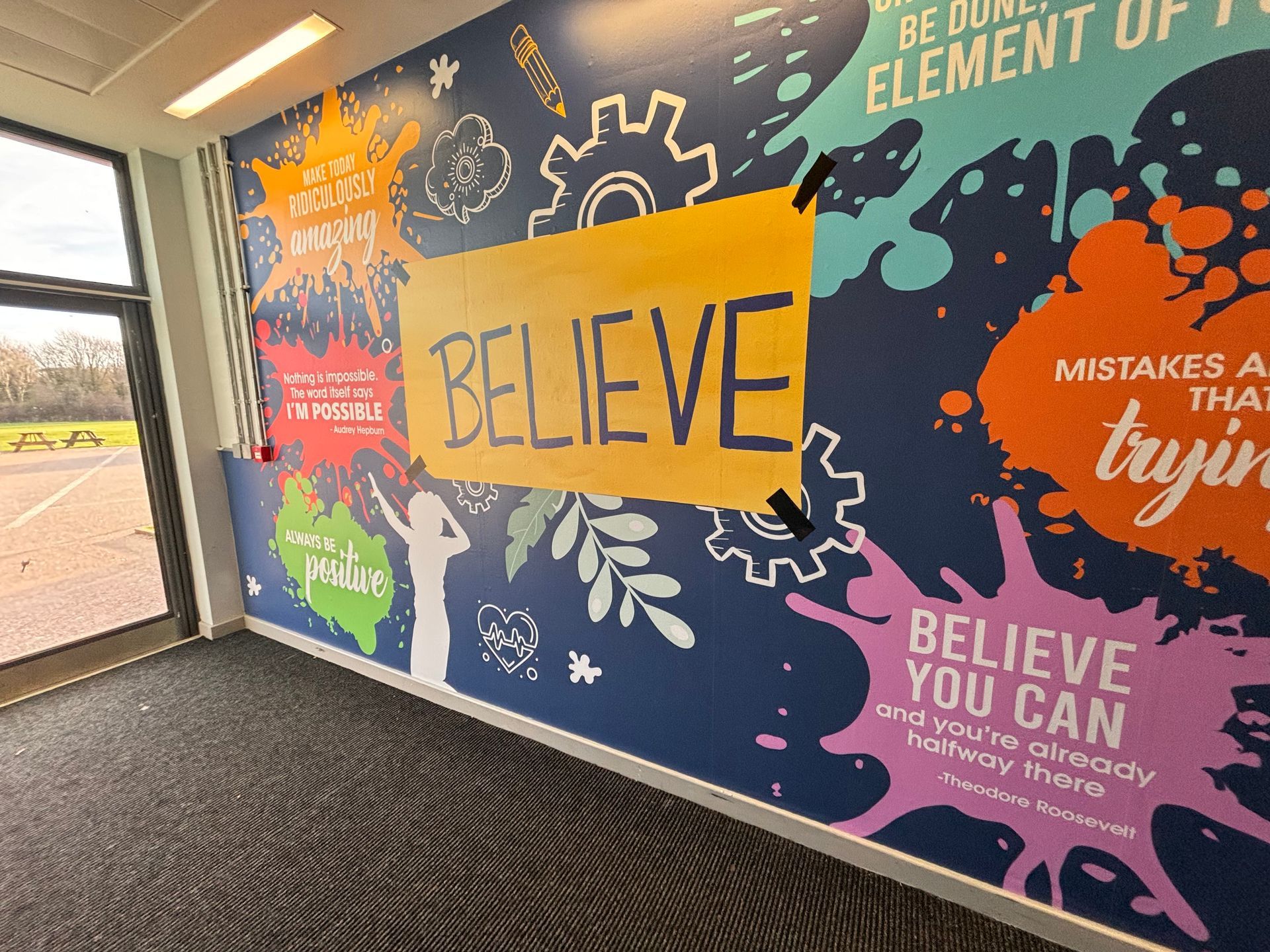Impact on schools-8
Using wall graphics to share the school's story can provide visitors, students and staff with an insight into the school's values, history and accomplishments. Here is a guide on how to create and incorporate wall graphics that effectively convey the school narrative;

Critical Components of Narrative Wall Graphics
1. Historical Timeline;
- Foundation and Milestones: Develop a timeline that showcases the school's establishment, essential milestones, key events and notable achievements.
- Balancing Visuals and Text: Use a combination of images, symbols, and concise text to maintain an informative timeline.
2. Accomplishments and Recognitions;
- Academic Excellence: Feature accomplishments, awards received, and recognition for both students and faculty members.
- Sports Achievements: Highlight victories in sports competitions, club activities, success stories, and other achievements in pursuits.
3. Community Engagement and Cultural Representation;
- Inclusive Portrayal: Incorporate elements and anecdotes that celebrate the diversity and inclusivity within the school community.Cultural Celebrations: visuals that honour festivities, traditions and events celebrated within the school.
Noteworthy Graduates;
- Achievement Stories: Showcase accomplished alumni and their successes, demonstrating how the school has contributed to their achievements.
- Motivational Quotes: This section features quotes from alums reflecting on their experiences at the school and how they influenced their paths.

Placement Strategy for Storytelling
1. Entryways and Foyers;
- Welcoming Narrative: The storytelling journey begins at the entrance with a mural introducing the school's heritage and fundamental values.
- Digital Exhibits: Utilise screens to display engaging content like videos, alum interviews, and virtual tours.
2. Corridors and Hallways;
- Thematic Corridors: Design corridors with themes such as "Our Past ", "Academic Excellence ", and "Community Unity," each narrating a part of the school's history.
- Interactive Timelines: Incorporate features like touchscreens or QR codes linking to stories, videos and documents.
3. Classrooms and Study Areas;
- Subject-centric narratives: Integrate graphics in classrooms that highlight the evolution of subjects, fundamental discoveries, and contributions by individuals in the field.
- Let's set up learning areas where students can share their findings, such as facts they've uncovered or projects they've completed.
4. For Common Spaces and Cafeterias;
- Community Boards: spots for a "Wall of Fame" showcasing student accomplishments, community service initiatives and other contributions to the school's atmosphere.
- Festive Artwork: Bright and lively graphics to commemorate events, festivals and school customs.
Implementation Approach
1. Collaborative Planning Process;
- Engage Stakeholders: Get students, teachers, staff and alums involved in the planning process to gather stories and viewpoints.
- Professional Design Input: Collaborate with designers to craft top-notch graphics that effectively narrate the school's history.
2. Material Choices;
- Sturdy and Eco-Friendly: Choose long-lasting, eco-friendly materials to ensure the longevity of the graphics while aligning with sustainability values.
- Safety Standards: Use safe and non-toxic materials while meeting safety regulations.
3. Expert Installation;
- Skilled Installation Team: Employ professionals to guarantee the application of the graphics without alignment issues or damage.
- Harmonious Blend: Ensure the graphics seamlessly blend with the school architecture and decor.1. Keeping Things Fresh and Updated;
- Regular Maintenance: Make sure to schedule upkeep to maintain the dynamic look of the graphics.
- Content Updates: It's essential to plan for revisions to ensure the content stays current and reflects the achievements and developments in the school's journey.
Examples of Engaging Narrative Wall Displays
1. Capturing History;
Design and craft a timeline showcasing the school's past milestones, such as founding dates, key accomplishments, and noteworthy alumni.
Impact: This gives visitors and students insight into the school's legacy and growth.
2. Showcasing Achievements;
Design: Create a display wall featuring successes, sports triumphs and extracurricular accomplishments through a mix of photos, trophies and informative text.
Impact: By highlighting student and staff achievements, this display fosters. Motivates others within the school community.
3. Alumni Spotlights;
Design: Share stories of alums featuring their photos, career highlights, and quotes about their experiences at the school.
Impact: This section showcases how the school has influenced its students over time through real-life success stories that inspire students.
4. Embracing Cultural Diversity;
Design: Develop graphics honouring traditions and events within the school community using vibrant imagery and engaging descriptions.Impact: Encourage a feeling of inclusiveness and appreciation for differences, ensuring that every student feels respected and valued.
Closing Thoughts
Educational institutions can establish an immersive setting that informs and motivates by incorporating wall designs that narrate the school's journey, accomplishments, and community. These visual elements reflect the school's principles and triumphs, fostering a sense of dignity and belonging among students, faculty, and guests. This method not only elevates the school's charm but also strengthens everyone's bond with the distinctive story and ethos of the institution.








